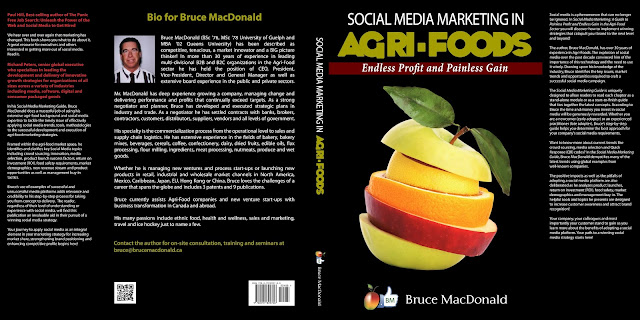Published in Food Product Design May 6, 2013
The book is available on Amazon and Kindle for $4.99 USD. Visit amazon/Kindle to order now:
http://www.amazon.ca/Social-Media-Marketing-Agri-Foods-ebook/dp/B00C42OB3E/ref=sr_1_1?s=digital-text&ie=UTF8&qid=1364756966&sr=1-1
Written by Bruce MacDonald, a 30 year veteran of the Agri-food industry, in "Social Media Marketing in Agri-Foods: Endless Profit and Painless Gain", Bruce applies his background and expertise in Agri-foods and social media to the latest trends, tools and methodologies needed to craft a successful on-line campaign. While the book focuses on the Agri-food market specifically, I believe that many of the points Bruce makes are equally applicable to most other industries.
GALWAY, Ireland—More than 1 billion people are classified as overweight and obese around the world, while an estimated 868 million are undernourished. This paradox is examined in a new book, “Diversifying Food and Diets," which explores the concept of agricultural biodiversity, in the context of the challenge of under-nutrition in many parts of the developing world and unhealthy diets in developed countries.
Agricultural biodiversity has a key role to play in food and nutritional security, according the book’s authors. Such biodiversity can be a safeguard against hunger, as well as a source of nutrients for improved dietary diversity and quality. It also can strengthen local food systems and environmental sustainability.
Currently, 195 million children around the world, under age 5 years, are stunted from malnutrition. Meanwhile, in developed countries, obesity has been linked to the rise of chronic diseases, such as cancer, diabetes and heart disease.
“It’s a question not only of the quantities of food people are eating but also the quality of that food," said the book’s co-editor Professor Danny Hunter, adjunct lecturer in botany and plant science (BPS) at NUI Galway and theme leader for Agrobiodiversity in the NUI Galway Plant and AgriBiosciences Research Centre (PABC).
Hunter said it is essential to understand how the global agricultural system and the benefits derived from agricultural biodiversity influence the drivers of global dietary consumption patterns, nutrition and health status, in particular in the developing world. The lack of diversity is shown to be a crucial issue, particularly in the developing world where diets consist mainly of starchy staples with less access to nutrient-rich sources of food, such as animal proteins, fruits and vegetables.
“As this book highlights, local biodiversity has the potential for contributing to food security and nutrition, as well as for enhancing adaptation to global climate change. Some of these species are highly nutritious and have multiple uses."
The book uses examples and case studies from around the globe to explore strategies for improving nutrition and diets, and identifies gaps in current knowledge that need to be addressed to better promote agricultural biodiversity. Case studies include a project in India which promotes nutritious native millets, efforts to identify and develop nutritionally rich indigenous vegetables and fruit trees in sub-Saharan Africa, and a UK-based community group’s urban gardening approach.
Hunter said while the book aimed to highlight some of the available options for improving the use of agricultural biodiversity, there was no silver bullet for the serious challenges facing the global population in the production, distribution and healthy consumption of food
“People need to consider ways of diversifying and improving their diets, which really does require a major transformation of the global food system. This will become an even greater challenge with the global population expected to reach around nine billion by 2050," he said.
Check out my latest e-book entitled: "Social Media Marketing in Agri-Foods: Endless Profit and Painless Gain".
The book is available on Amazon and Kindle for $4.99 USD. Visit amazon/Kindle to order now:
http://www.amazon.ca/Social-Media-Marketing-Agri-Foods-ebook/dp/B00C42OB3E/ref=sr_1_1?s=digital-text&ie=UTF8&qid=1364756966&sr=1-1
Written by Bruce MacDonald, a 30 year veteran of the Agri-food industry, in "Social Media Marketing in Agri-Foods: Endless Profit and Painless Gain", Bruce applies his background and expertise in Agri-foods and social media to the latest trends, tools and methodologies needed to craft a successful on-line campaign. While the book focuses on the Agri-food market specifically, I believe that many of the points Bruce makes are equally applicable to most other industries.


No comments:
Post a Comment